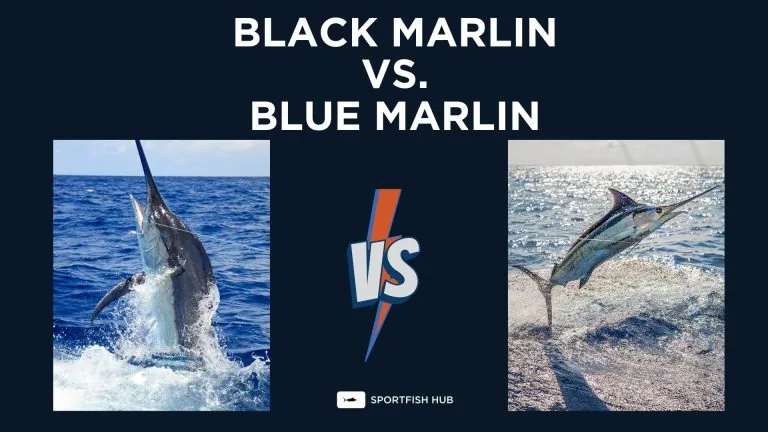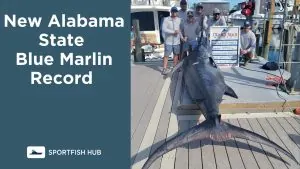If you’re a fisherman, marine biologist, or simply an enthusiast interested in marlin species, this guide is for you.
We’ll dive deep into the differences between the Black Marlin and Blue Marlin, covering everything from their physical characteristics to their preferred habitats.
By the end of this guide, you’ll be able to easily identify each species, even if you’re a novice to marlin.
Table of Contents
- Physical Characteristics
- Quick Reference Guide (Black Marlin and Blue Marlin)
- Additional characteristics
- Habitats of Black Marlin and Blue Marlin
- Identification Guide for Beginners
- FAQ
- What do Black Marlin and Blue Marlin eat?
- Are Black Marlin and Blue Marlin endangered?
- How big can Black Marlin and Blue Marlin get?
- What is the lifespan of Black Marlin and Blue Marlin?
- When is the best time of year to fish for Black Marlin and Blue Marlin?
- Conclusion
Physical Characteristics
Understanding the physical differences between the Black Marlin and Blue Marlin is key to identifying them. Here are the main distinguishing features:
- Speed: Blue Marlin are faster swimmers than Black Marlin. This trait often makes Blue Marlin more challenging to catch.
- Head and Bill: Black Marlin have thicker heads and shorter bills, often downturned slightly. In contrast, Blue Marlin have a thinner bill and a more streamlined appearance.
- Dorsal Fin: The dorsal fin of a Blue Marlin is taller than that of a Black Marlin.
- Pectoral Fins: The pectoral fins of a Black Marlin are rigid and do not fold flush against its body. On the other hand, the pectoral fins of a Blue Marlin fold easily against the fish’s sides.
Quick Reference Guide (Black Marlin and Blue Marlin)
| Black Marlin | Blue Marlin | |
|---|---|---|
| Speed | Slower | Faster |
| Head and Bill | Thicker head and shorter bill | Thinner bill and more streamlined appearance |
| Dorsal Fin | Shorter | Taller |
| Pectoral Fins | Rigid and do not fold flush against the body | Fold easily against the sides |
| Coloration | Dark blue above the lateral line, fading to hues of green or gold, then to shades of silver or white below | Vividly blue with shades of purple, frequently with iridescent blue vertical stripes running the length of the body |
| Habitat | Prefer shallower waters, closer to the surface | Prefer deeper waters, often found in open oceans |
Additional characteristics
Above were some of the more obvious differences between a Black Marlin and a Blue Marlin; however, there are a few more subtle differences that are worth mentioning:
- Coloration: Black Marlin are predominantly very dark blue above the lateral line, quickly fading to hues of green or gold, then to shades of silver or white below. They can display faint blue vertical stripes. Blue Marlin, on the other hand, are often vividly blue with shades of purple, frequently with iridescent blue vertical stripes running the length of the body.
- Branchiostegals: These refer to the bony elements in the umbrella-like membrane on a marlin’s throat below the gill plates or operculum. A Black Marlin’s branchiostegals are much longer and reach farther back to the rear edge of the operculum than a Blue Marlin’s. This gives the appearance of a bigger head and, in addition to the thicker shoulders, makes a Black Marlin look like it’s got way more weight forward than aft.
- Second Dorsal and Anal Fins: These can be definitive but are really only helpful if the fish is lying quietly on its side next to the boat or hanging at the dock. If the origin or start of the second dorsal occurs at a point before where the second anal fin occurs, you have a Black Marlin. If you see the exact opposite, then it’s a Blue Marlin.
Habitats of Black Marlin and Blue Marlin
The habitats of Black Marlin and Blue Marlin are largely influenced by their preferences for different water depths and conditions.
Black Marlin Habitats
Black Marlin are typically found closer to the surface, at around 50 fathoms or less. This preference for shallower waters often leads them to areas with abundant food sources and warmer temperatures.
Black Marlin are known to frequent areas of broken ground, rock piles surrounded by flats, and coral reef systems that hold varieties of baitfish. These environments can be target-rich for Black Marlin, especially when bait is present in large quantities.
One notable habitat for Black Marlin is the Zane Grey Reef just outside Pinas Bay, Panama. This area holds bait in large quantities and is a small rock pile coming up from about 300 feet with a few small satellite peaks looming in the flats that surround it.
When conditions are right, Black Marlin will pile up in this tight area and tear through schools of bait.
Blue Marlin Habitats
On the other hand, Blue Marlin prefer deeper waters, at around 100 fathoms or more. This preference for deeper waters is often linked to their faster swimming speeds and their ability to dive deep to hunt for food.
Blue Marlin are often found in open oceans, far from land. They are highly migratory and can travel long distances in search of food and for spawning. Their habitat is generally offshore in waters over 100 meters deep, and they are known to dive to depths of up to 800 meters.
In summary, while both species can be found in similar geographical locations, their preferences for different water depths and conditions lead them to occupy different habitats within those areas. Understanding these habitat preferences can be crucial for successful marlin fishing.
Identification Guide for Beginners
For those new to marlin fishing, here’s a beginners guide to identifying Black Marlin and Blue Marlin:
- Look at the speed: If the fish is swimming exceptionally fast, it’s likely a Blue Marlin.
- Examine the head and bill: A thicker head and shorter bill indicate a Black Marlin, while a thinner bill and more streamlined appearance suggest a Blue Marlin.
- Check the dorsal fin: A taller dorsal fin points to a Blue Marlin, while a shorter one suggests a Black Marlin.
- Observe the pectoral fins: If the pectoral fins are rigid and do not fold flush against the body, you’re looking at a Black Marlin. If they fold easily against the fish’s sides, it’s a Blue Marlin. (This is my go-to method)
Remember, practice makes perfect. The more you observe these species, the better you’ll become at distinguishing between them.
FAQ
What do Black Marlin and Blue Marlin eat?
Both Black Marlin and Blue Marlin are carnivorous and feed on a variety of fish and cephalopods. Their diet primarily includes smaller fish like tuna and mackerel, as well as squid. Their speed and agility make them excellent hunters in the ocean.
Are Black Marlin and Blue Marlin endangered?
As of my knowledge cutoff in September 2021, both Black Marlin and Blue Marlin were listed as “Vulnerable” on the IUCN Red List of Threatened Species. This means they are at a high risk of endangerment in the wild. Overfishing is the main threat to these species, and conservation efforts are in place to protect them. For the most current status, please refer to the latest updates from the International Union for Conservation of Nature (IUCN).
How big can Black Marlin and Blue Marlin get?
Both species can grow quite large, but their maximum sizes differ. Black Marlin are known to reach lengths of up to 4.65 meters (15.3 feet) and can weigh as much as 750 kilograms (1650 pounds). Blue Marlin, on the other hand, can reach lengths of up to 5 meters (16.4 feet) and weigh as much as 820 kilograms (1800 pounds). However, females are typically much larger than males in both species.
What is the lifespan of Black Marlin and Blue Marlin?
Both Black Marlin and Blue Marlin have similar lifespans. They can live for up to 20 years in the wild, although this can vary depending on factors such as predation, disease, and human fishing activities.
When is the best time of year to fish for Black Marlin and Blue Marlin?
The best time to fish for these species can vary depending on the location. In general, Black Marlin are most commonly caught in the late summer and fall months, while Blue Marlin are often caught in the summer. However, these fish are highly migratory and their presence in specific areas can change based on factors like water temperature and food availability. Local fishing guides and resources can provide the most accurate information for specific regions.
Conclusion
Understanding the differences between Black Marlin and Blue Marlin is not only fascinating but also crucial for successful fishing. Whether you’re a seasoned fisherman or a novice, this guide should help you identify these majestic creatures with ease. Happy fishing!












